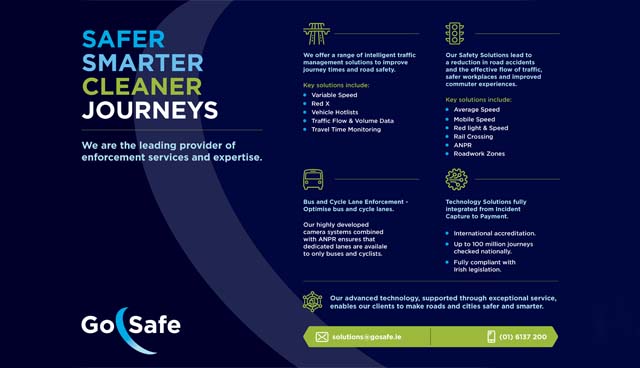GoSafe: Promoting safer, smarter, cleaner journeys

Communities nationally face challenges in ensuring safer, easier mobility options for all users. GoSafe is a leader in safe, smart, and clean transportation. We serve our customers by providing technology-based solutions to make mobility safer, smarter, and cleaner.
Safer
Speeding, reckless, and distracted driving continues to have a profound and devastating impact on drivers, passengers, and families.
We support safer communities by installing, maintaining and managing technology solutions that positively impact on driver behaviour, enhance road safety and optimise traffic mobility. Partnering with stakeholders, we create the foundation for a safe transportation ecosystem. We work with customers by installing leading photo enforcement technology to positively impact driver behaviour and enhance road safety. These include bus lane, red light, railway crossing, speed, and distracted driving cameras.
Protecting our vulnerable school children is at the forefront of our approach and we support periodic speed limit solutions which allows authorities to reduce speed limits at the approaches to schools during school times.
At GoSafe, we focus on safer mobility solutions for the most vulnerable road users to help make sure that everyone arrives home safely.
Smarter
As part of a network operating around the globe, GoSafe sits at the centre of the mobility ecosystem, one that brings together vehicles, devices, information, and people to solve the most complex challenges faced by our customers.
Smarter technologies we utilise include variable speed limits on motorways that allows operators to smooth the flow of traffic by regulating speeds. This measure works by triggering a reduction in speed limits before congestion reaches a critical level minimising flow breakdown and improving journey reliability. Another use-case is where variable speed technology is proactively utilised to reduce speed limits on roads with microclimates that are susceptible to intense rain, hail, or snow.
Our ‘Red X’ solutions indicate a hazard, breakdown, or the presence of emergency services on the motorway ahead. The driver is automatically altered to lane closures giving them time to adjust their driving to altered conditions ahead.
Cleaner
Everyone deserves to breath clean air and our technologies have the power to help change the world, from saving lives to the environment. Our average and variable speed technologies encourage motorists to drive in a smoother manner helping to reduce fuel consumption, noise pollution and harmful omissions whilst our congestion and low/ultra-low emission zones for cities help clean up the air that we breathe.
T: +353 1 469 1200
E: info@egis.ie
W: www.egis-projects.ie






